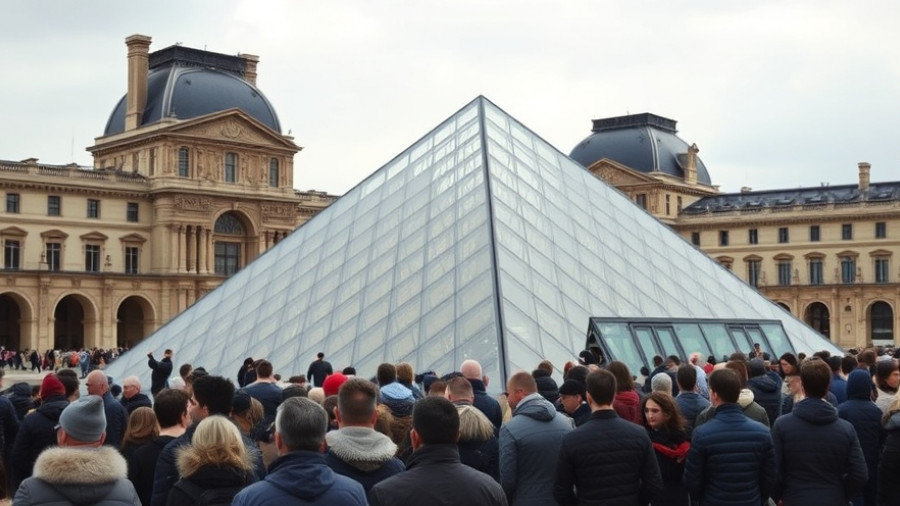
A Daring Heist: The Louvre's Crown Jewels Stolen
In a brazen daylight heist that sent shockwaves through France and the art world, the Louvre Museum, the world’s most visited museum, reopened just three days after thieves made off with some of the country’s most priceless treasures: eight pieces from the French Crown Jewels. The theft, which echoes historical thefts of cultural significance, highlights not only the audacity of the criminals involved but also raises alarming questions about the museum's security measures.
A Spectacular Theft
On Sunday, October 19, 2025, shortly after the Louvre opened its doors for the day, four thieves executed a precisely planned robbery that lasted less than four minutes. Utilizing a vehicle-mounted mechanical lift, they gained access to the Apollo Gallery, home to the Crown Jewels, by forcing open a window and smashing through two display cases using power tools. The stolen items included a sapphire diadem, several necklaces, a brooch known as the reliquary brooch, and Empress Eugénie’s diamond diadem, showcasing the thieves' intent on targeting valuable artifacts tied to France's illustrious history.
Political Fallout and Security Scrutiny
This incident has resulted in significant scrutiny of both President Emmanuel Macron and Louvre chief Laurence des Cars, especially in light of prior warnings about the museum's understaffing and inadequate security measures. Just months before the theft, staff had protested about the lack of resources, which now seems tragically prescient. Justice Minister Gérald Darmanin stated, "We have failed," as he acknowledged the negative portrayal of France following such an audacious crime.
The Cultural Significance of the Stolen Items
The items taken, valued at over $100 million, are not just valuable jewels; they hold immense historical and emotional weight. The emerald necklace and earrings from Empress Marie-Louise, for instance, date back to 1810 and are emblematic of the imperial legacy of the Napoleonic era. These artifacts represent more than mere opulence; they are parts of France's narrative, illustrating the artistry and craftsmanship of past centuries. Art recovery expert Arthur Brand emphasized the theft as "a national disaster" for France, one that threatens to erase significant pieces of their collective identity.
The Thieves: Who Are They?
While the police investigation is underway, information regarding the profiles of the thieves remains speculative. It is believed that these individuals were part of a larger organized crime group, as their exit strategy involved using scooters to escape the scene quickly. Initial reports hinted at one-third of the gallery lacking CCTV coverage, raising further concerns about security protocols and the effectiveness of the alarm systems in place.
The Aftermath: What’s Next?
As the Louvre reopens, the museum has opted not to comment on any additional security measures implemented post-heist. Visitors expressed mixed emotions, grappling with the excitement of witnessing art history yet feeling the haunting implications of a theft that reflects vulnerabilities in safeguarding national treasures. Some reports suggest the thieves may try to dismantle the jewels for profitable resale, further obliterating their historical contexts.
A Call for Improved Security Measures
Culture Minister Rachida Dati has indicated that following this event, thorough investigations will shape future strategies to enhance security not just at the Louvre, but across French cultural institutions. Multiple art experts suggest that these incidents spotlight a growing trend of museum heists, urging for government-led initiatives toward robust security frameworks to protect invaluable heritage.
Reluctant Returns?
As the Louvre moves forward, the emotional toll of this theft will linger. The cultural fabric of France is woven with stories such as those embodied by the Crown Jewels, and their temporary loss sheds light on the fragility of recognizing, preserving, and valuing history—and the need for collective responsibility in safeguarding it.
Childhood memories of family visits to the Louvre may blend with recent headlines of theft, highlighting the need not only for security improvements but also for public engagement in cultural stewardship. The hope is that through concerted efforts, France can ensure that such monumental treasures remain protected for future generations to admire and learn from.
As community members in Bakersfield and around the globe reflect on this significant cultural loss, it serves as a poignant reminder of our shared responsibility toward preserving heritage—both locally and globally.
Stay informed about the latest developments in museum security policies and join the conversation on how we can collectively ensure the safekeeping of our shared cultural heritage.
 Add Row
Add Row  Add
Add 



Write A Comment